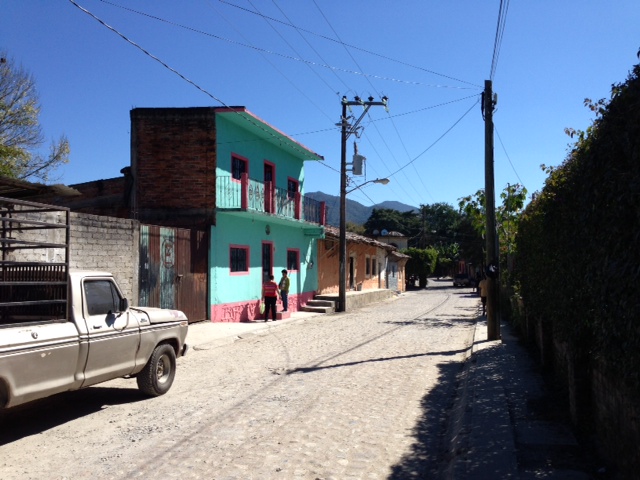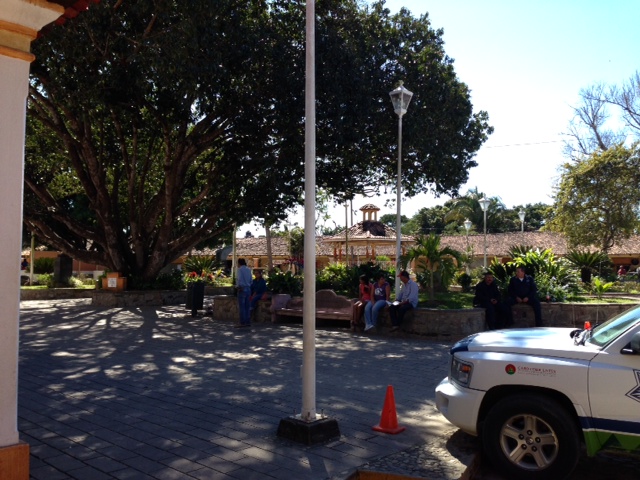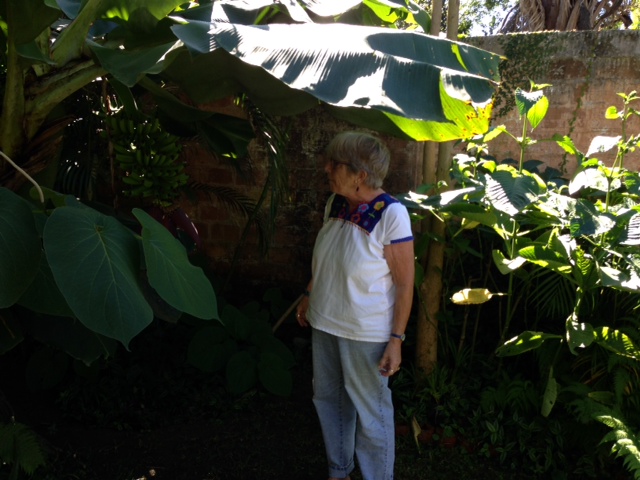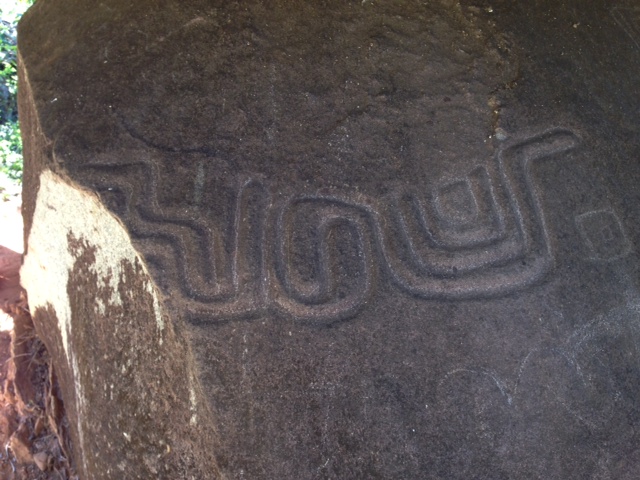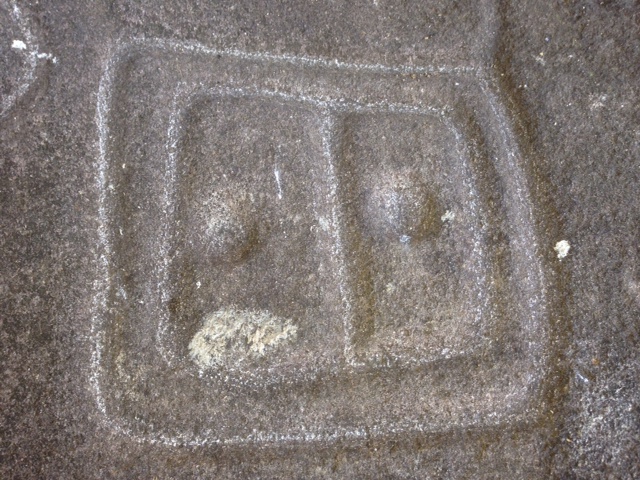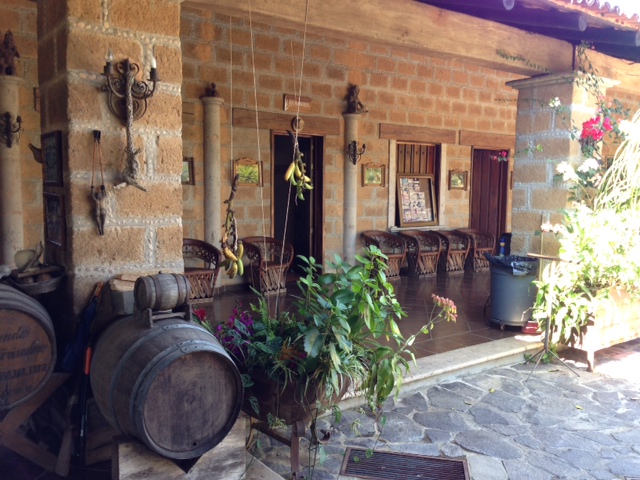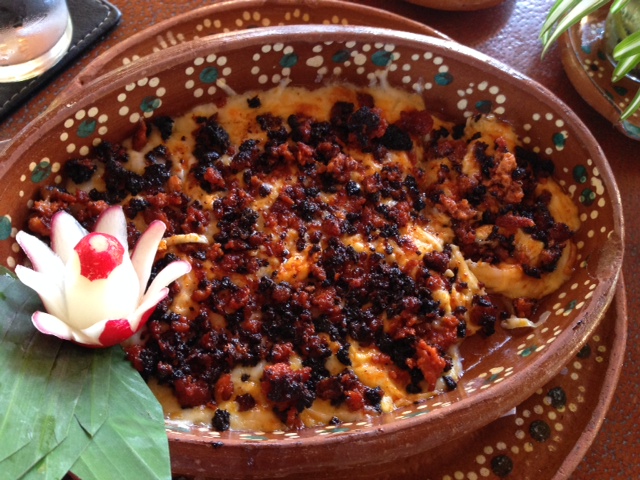Hola, and welcome to OnVallartaTime! In this post we will again go outside the city of Puerto Vallarta, on a side trip to the small town of El Tuito. But meanwhile, to catch you up on our activities…
We continue to have visitors. However, Linda left earlier this week and Liep left today, once again paring our gang down to three. Eve will be here for the rest of the month. With visitors to entertain, we have been going out to eat much more than when we were on our own. We will have to stop soon, or we will all need extender seat belts on the way home! Still, we have managed to get some beach time in, and without a doubt this is a great place to be no matter what we are doing every day.
Our friend Kai, whom we originally met through Eve, has lived in this part of the world for over 12 years. She owns a condo in La Palapa that she rents out, and also owns a house in the small town of El Tuito, so she splits her time between the two. Peggy and I spent some time with her when she was last in PV, and knowing we were going to have visitors, she invited our whole gang to visit her in El Tuito. So last Friday, we all piled on the bus for what turned out to be a great trip.
El Tuito is a town of 3,500 people an hour south of Puerto Vallarta. It’s a ranching community and has been since Colonial times. At an altitude of 3,000 feet it makes a good summer escape from the heat and humidity of PV. El Tuito, Tuitlán in the native Nahua dialect, means “place of God” or “place of beauty.” Buses are the intercity type, meaning they have upholstered seats (unlike the city buses). At twenty-some Pesos, the trip is a bargain. The views are spectacular, first along the coast through Mismaloya and Boca de Tomatlán, then up into the mountains to El Tuito.
The bus let us off a few blocks from the center of town, and we walked to the town square to meet Kai. We then walked the short distance to her house. The house is an oasis of calm and beauty, and is named “Casa Arbol” for the huge avocado tree growing up through the center. There is a beautiful garden area behind the house.
 The bus to El Tuito. It also goes to the Vallarta Botanical Gardens, a worthwhile trip in itself. As you board the bus, an enterprising man comes on selling slices of pizza from the restaurant on the corner.
The bus to El Tuito. It also goes to the Vallarta Botanical Gardens, a worthwhile trip in itself. As you board the bus, an enterprising man comes on selling slices of pizza from the restaurant on the corner.
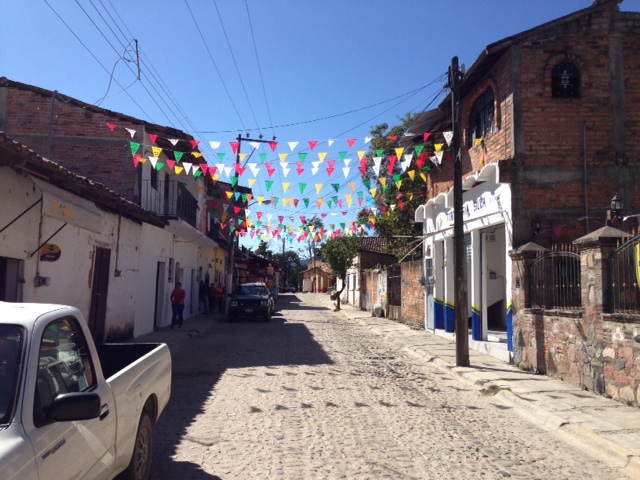 More El Tuito. The flags are from a local fiesta that just ended.
More El Tuito. The flags are from a local fiesta that just ended.
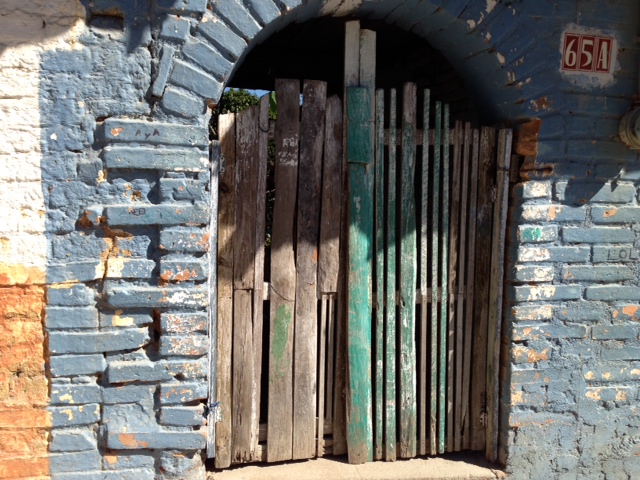 A picturesque door along the street in El Tuito
A picturesque door along the street in El Tuito
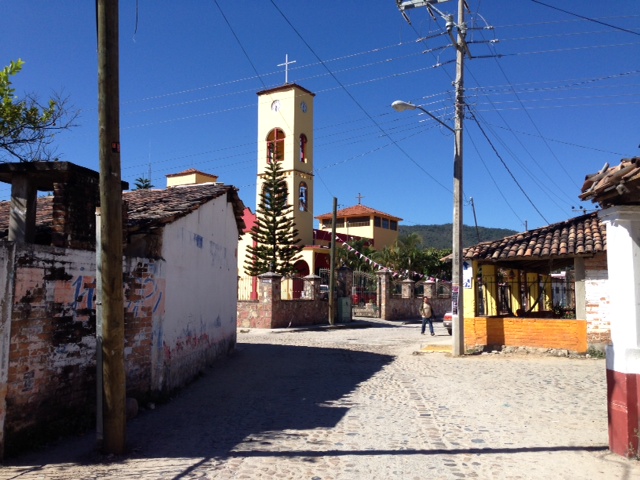 Looking toward the church and the town square
Looking toward the church and the town square
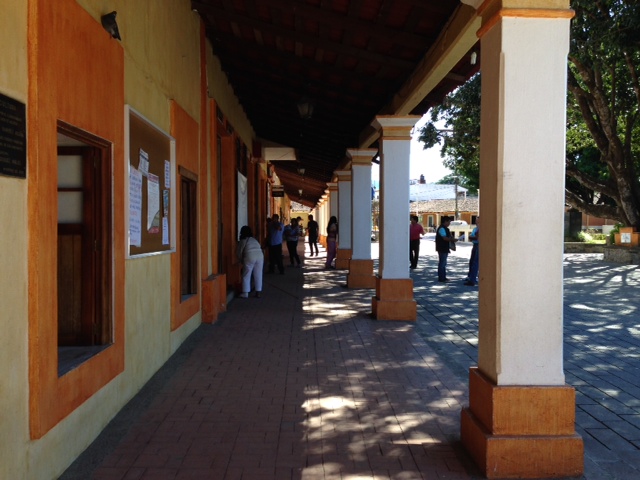 El Tuito municipal building fronting the square
El Tuito municipal building fronting the square
 A wall of flowers near Kai’s house
A wall of flowers near Kai’s house
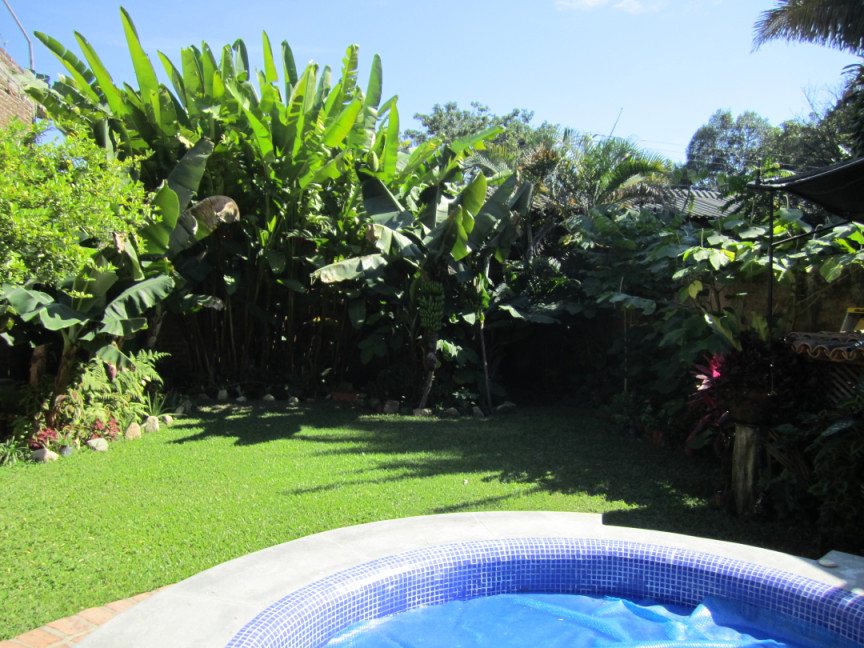 Garden area behind Kai’s house
Garden area behind Kai’s house
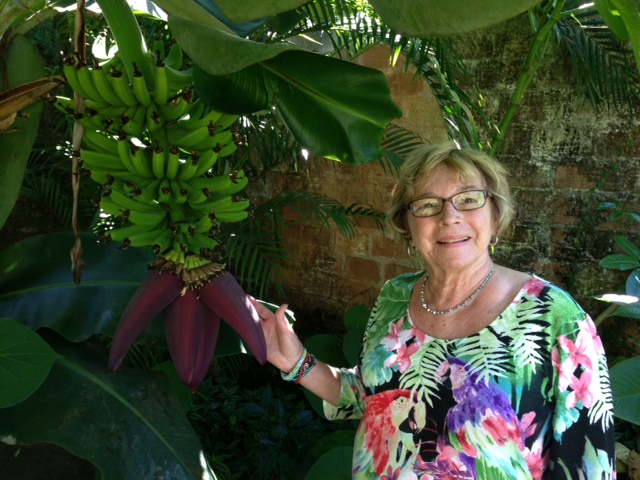 Peggy and a banana tree. Those purple things are the flowers.
Peggy and a banana tree. Those purple things are the flowers.
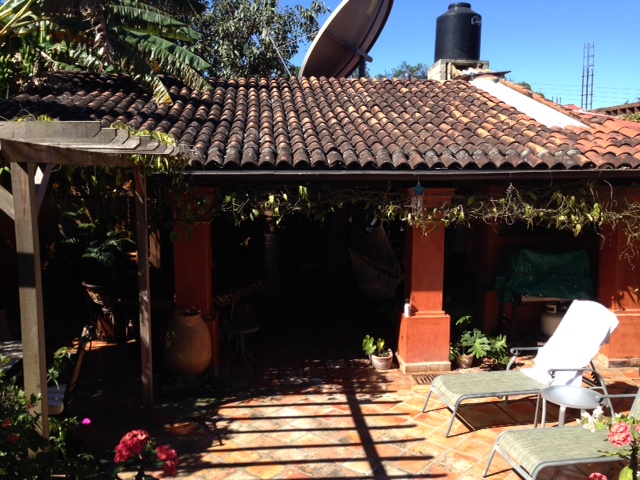 Looking back toward Kai’s house from the garden
Looking back toward Kai’s house from the garden
The last time we visited Kai in El Tuito she drove us to a marvelous restaurant and distillery called Hacienda Divisadero, and we wanted to repeat this trip for our friends. So Kai drove us down some backcountry roads past farms and ranches to the hacienda.
Once on the property of the hacienda, Kai had a surprise for us. She turned off the main road onto a small dirt track, through a gate (with prior permission from the family) and we stopped near a very large piece of granite on a hill above a river. Once we got out of the car and walked nearer, we could see that the rock was covered with prehistoric petroglyphs! According to Armando, who works at the hacienda and whom you will meet later in this post, the petroglyphs are over 1600 years old and there are over 70 glyphs on the ranch property. This particular rock was actually hauled up the hill from the river to its present location and is one of three such rocks, all equidistant several kilometers apart, and perfectly aligned from north to south.
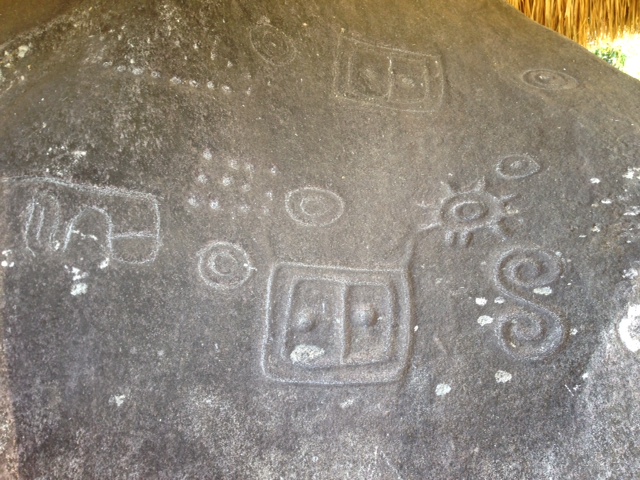 The face of the rock, covered with petroglyphs. The square one in the center is “a portal between worlds.”
The face of the rock, covered with petroglyphs. The square one in the center is “a portal between worlds.”
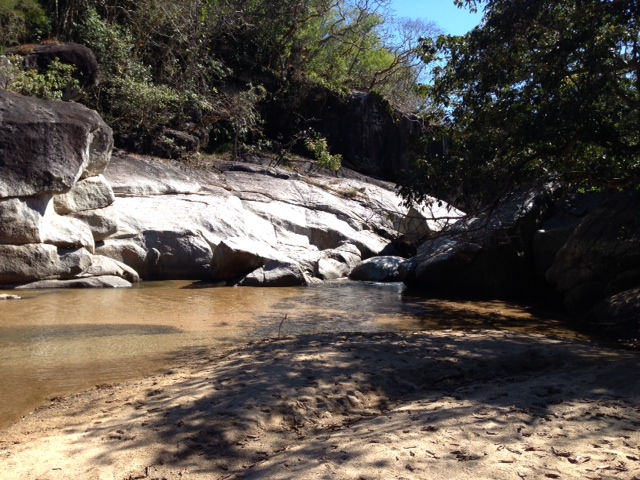 The river canyon down the hill from the petroglyph rock
The river canyon down the hill from the petroglyph rock
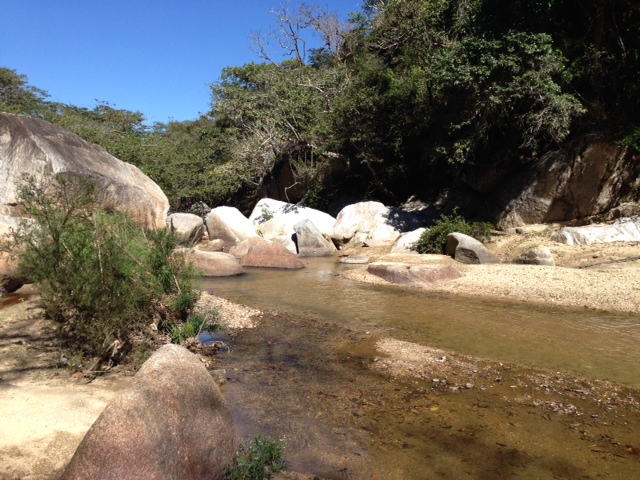 Looking the other way, downstream
Looking the other way, downstream
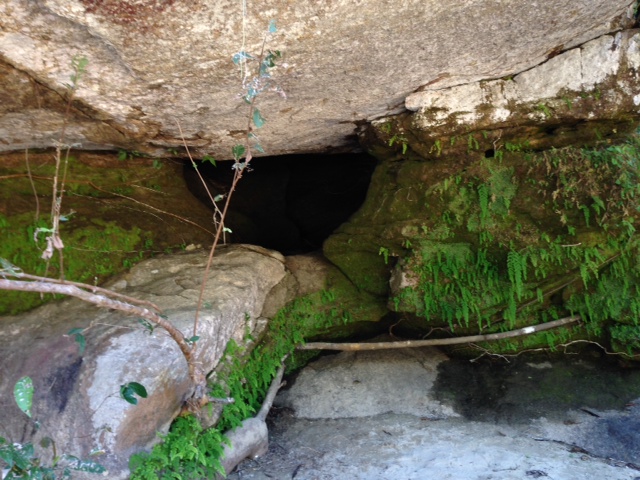 The sacred cave, a place for vision quests, meditation and astral traveling. New shamans are initiated at this spot.
The sacred cave, a place for vision quests, meditation and astral traveling. New shamans are initiated at this spot.
Once we had lingered for a while in the cool canyon next to the river, and had absorbed the amazing spiritual energy of the place, we walked back up the hill to the car and headed to the hacienda. Hacienda Divisadero is owned by a famous restauranteur from Puerto Vallarta, is built in the old hacienda style and is a very friendly and welcoming place. You can get a room here, go horseback riding to the petroglyphs, and generally relax. There are future plans to expand the available rooms to accommodate more visitors, and to create a health/ yoga/healing retreat. But for now, it’s a really great restaurant and distillery.
 A fighting cock ranch on the way to the hacienda. Each is tethered to his own little house, to keep them separated.
A fighting cock ranch on the way to the hacienda. Each is tethered to his own little house, to keep them separated.
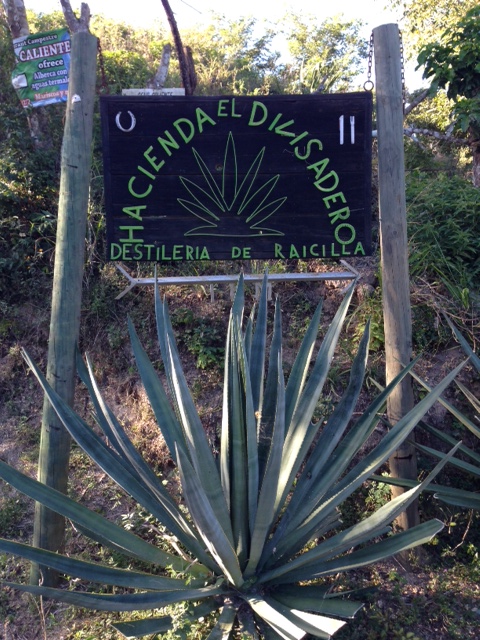 The sign welcoming visitors to the Hacienda Divisadero
The sign welcoming visitors to the Hacienda Divisadero
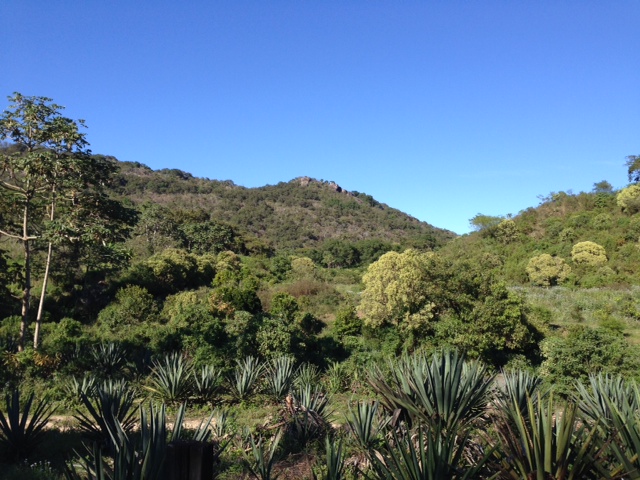 A view from the hacienda, with green agave plants in the foreground
A view from the hacienda, with green agave plants in the foreground
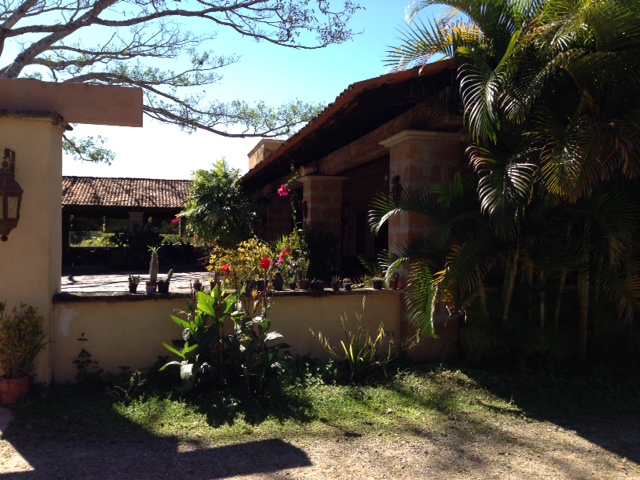 Entrance to the hacienda itself
Entrance to the hacienda itself
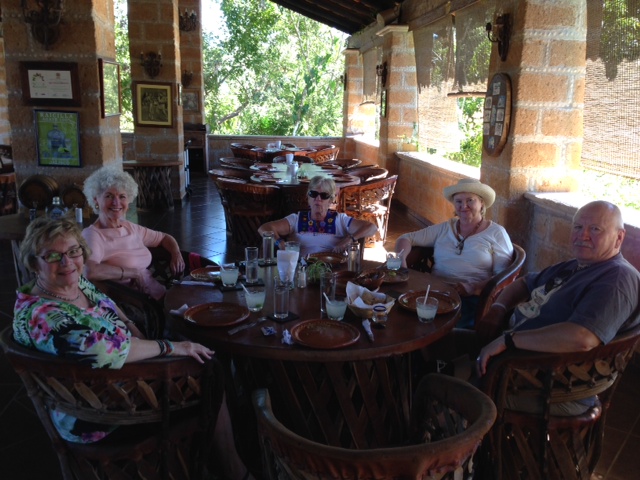 Our group at the restaurant — Peggy, Eve, Kai, Linda, and Liep. I’m behind the camera.
Our group at the restaurant — Peggy, Eve, Kai, Linda, and Liep. I’m behind the camera.
Now to the raicilla (rye-SEE-ya)! There is a raicilla distillery next to the hacienda building itself. Raicilla is the local moonshine, which has only recently become legal (although it’s always been available for purchase along the road or from private houses). “Tequila” is named after a region in the state of Jalisco and is made exclusively from the blue agave plant. Only the product from the region of Tequila can legally be called “tequila,” much like Champagne in France. Raicilla, on the other hand, is made from the green agave, and while the production of the liquor is much the same, the taste is very different. It can range from battery-acid harsh to smooth, refined and elegant. The herbal flavor of the agave comes through, and it often has a smoky taste, much like the finest single-malt Islay scotch, from the method of roasting the heart of the agave in wood-burning ovens.
There are some legends about raicilla, chief among them that it has hallucinogenic properties from the agave. While it’s often very strong (the alcohol percentage can vary widely) I personally haven’t noticed any effects other than from the alcohol. But that’s plenty!
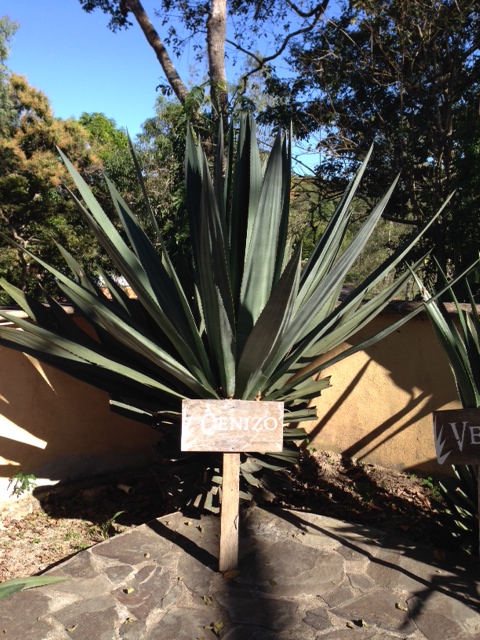 The green agave plant. There are several varieties. Not a true cactus, agaves are related to aloes.
The green agave plant. There are several varieties. Not a true cactus, agaves are related to aloes.
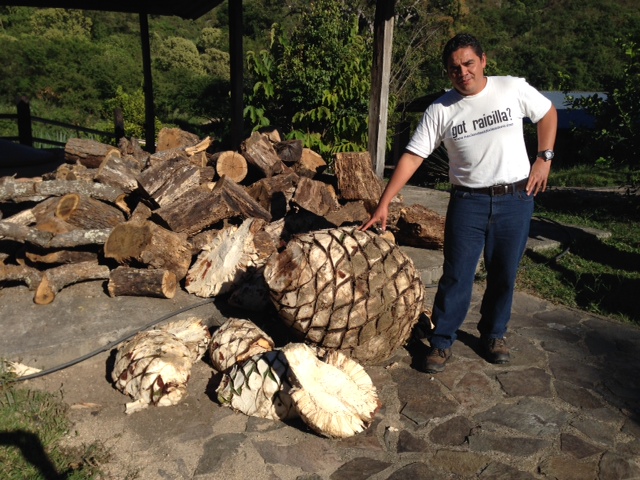 Armando, who works at the hacienda, showing us an agave “piña,” so called because it looks like a pineapple. When the agave plant flowers, which sometimes takes ten years, it is harvested. The leaves are cut off with a machete, leaving the heart. The heart is then cut up with axes. That’s the local oak in the background, used for roasting the agave heart.
Armando, who works at the hacienda, showing us an agave “piña,” so called because it looks like a pineapple. When the agave plant flowers, which sometimes takes ten years, it is harvested. The leaves are cut off with a machete, leaving the heart. The heart is then cut up with axes. That’s the local oak in the background, used for roasting the agave heart.
By the way, the lore above, about the petroglyphs and the sacred places on the river comes from Armando, who is studying to become a shaman and healer for his people. Meanwhile he is managing the restaurant at the hacienda. He is the nephew of the owner.
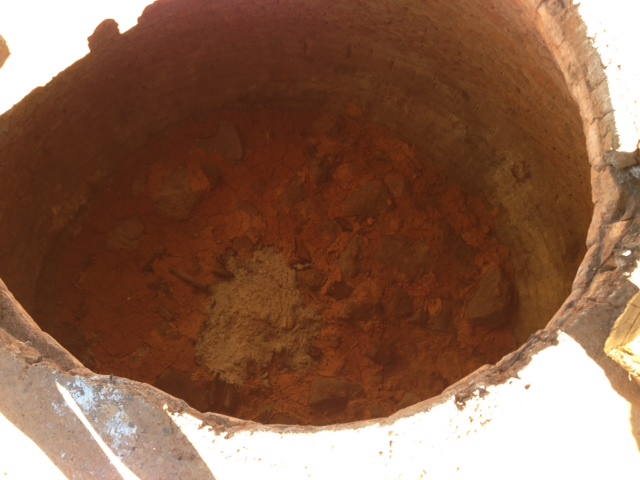 This is the oven, a deep brick-lined pit. A wood fire is built to heat up the oven, the chunks of agave heart are thrown in along with more wood, and the oven is sealed up tight for at least a day. A small door can be opened to check the progress of the roasting and towards the end water is added to make sure the heart is cooked through. After cooking, the heart is called a “mezcal.”
This is the oven, a deep brick-lined pit. A wood fire is built to heat up the oven, the chunks of agave heart are thrown in along with more wood, and the oven is sealed up tight for at least a day. A small door can be opened to check the progress of the roasting and towards the end water is added to make sure the heart is cooked through. After cooking, the heart is called a “mezcal.”
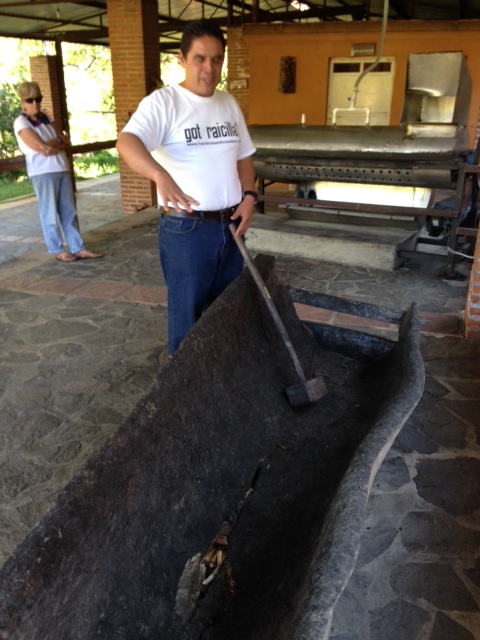 Armando is demonstrating the old way of crushing the cooked heart, the mezcal. This job is now done with the ingenious machine behind him. That’s Kai in the background.
Armando is demonstrating the old way of crushing the cooked heart, the mezcal. This job is now done with the ingenious machine behind him. That’s Kai in the background.
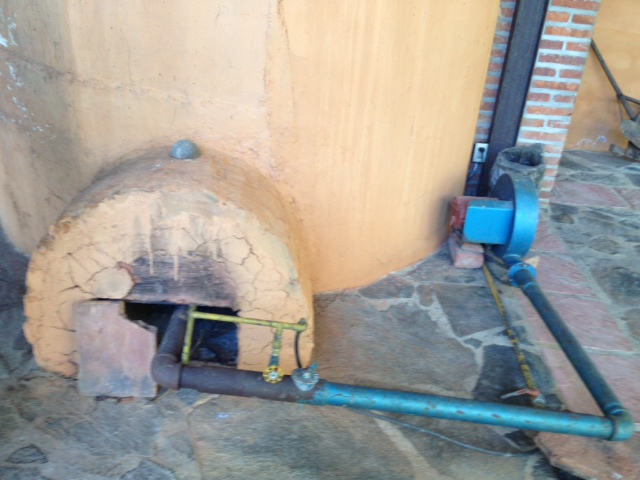 After fermenting the mezcal with water for about a week, the distillation tanks are heated up
After fermenting the mezcal with water for about a week, the distillation tanks are heated up
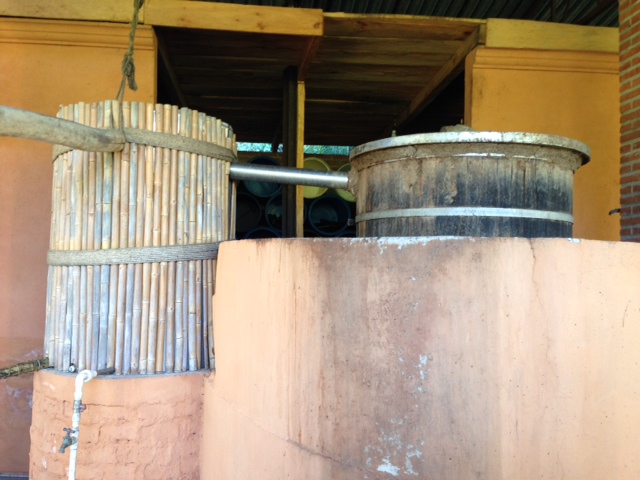 The heated mixture is passed through coils in these water tanks where cool water flows in the bottom and out the top.
The heated mixture is passed through coils in these water tanks where cool water flows in the bottom and out the top.
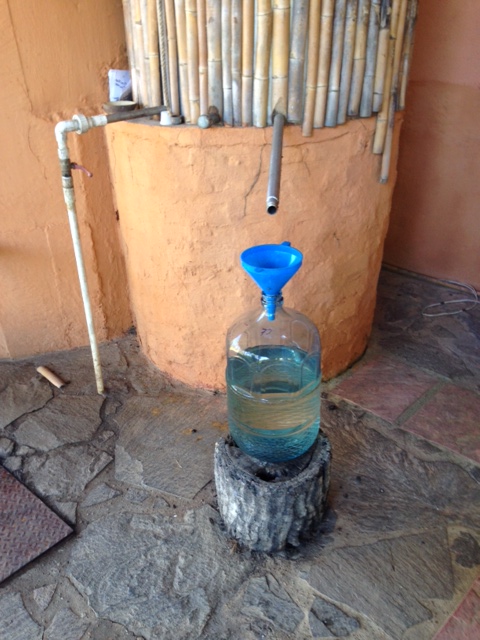 The distilled raicilla, at this point nearly pure alcohol, drips out here. The raicilla is mixed with water to assure uniform alcohol content and aged in barrels.
The distilled raicilla, at this point nearly pure alcohol, drips out here. The raicilla is mixed with water to assure uniform alcohol content and aged in barrels.
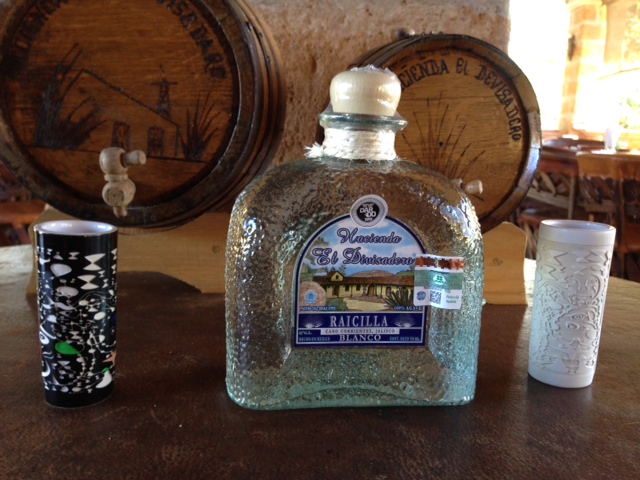 The final product, for sale in the restaurant
The final product, for sale in the restaurant
That’s it for this week; I hope you have enjoyed this post of OnVallartaTime! As a parting shot, here’s a picture of an egret sentinel on a lifeguard stand at sunset.
